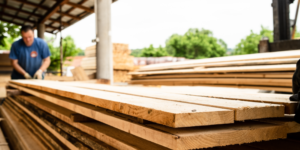
After a tumultuous 2020 in which COVID-19 shutdowns, wildfires across the Western US, and a surprising residential project boom caused a lumber shortage, contractors are wondering when suppliers’ now record-high price on lumber might ever return to the pre-pandemic norm.
The answer to that question — much like “Is the pandemic’s end in sight?” — is quite murky.
Multiple compounding factors came into play for lumber to rise to such unprecedented heights in cost and scarcity. However, the ongoing pandemic and current housing market are telltale signs that it is almost certain to remain within the “new normal’s” $800> ballpark for the foreseeable future — with looming doubt they could ever possibly get lower.
Last September, Tom Scalisi broke down just how the lumber shortage came to be and its impact on builders. The pandemic caused widespread shutdowns of lumber mills and the implementation of socially distant health protocol, which starkly curbed production. The year also brought a surge in home construction, renovation, and remodeling projects.
This was just before the material broached the historic $1,000 per 1,000 board feet spot price point, kickstarting a volatile three-month-long period where analysts saw the figure drop to as low as $500 — before rocketing back up towards the near-$900 mark.
Now, with the spot price for lumber just north of the all-time record high at $1,004.90 per 1,000 board feet according to Random Length Lumber Futures, wood has now doubled from where it stood just three months ago.
Such an unparalleled leap in cost pales from future models published last September, which predicted that it would significantly decrease to around $530 six months out from the date of reporting.
Many builders and future homeowners were pre-ordering from suppliers, often with months-long delays, piling on stress to both parties and an average $14,000 in added costs to home starts, according to the National Association of Home Builders.
2020 residential construction uptick increased lumber demand
When COVID-19 forced business lockdowns and stay-at-home orders in early March of last year, the construction industry was put on pause before determining how projects could continue as safely as possible.
Commercial projects eventually resumed, but for many workers, the housing market was the biggest and most surprising sector of hope amidst an initially bleak climate thanks to a perfect economic storm in the suburbs.
Home construction jumped 22.6% from June to July 2020 — a 10% increase from 2019, according to monthly tracked building permit data from the US Census Bureau.
This, combined with the highest record new home sales since 2006 (up 36% year over year) in part of the decreasing mortgage rates to an all-time low of 2.65% last month, made for a residential construction boom. Many homeowner’s initial weeks at home in quarantine led to a flurry of renovation/remodeling desires.
However, projects would soon be met with unexpected setbacks due to lumber’s dwindling supply, thanks to wildfires across the Western US and increased tariffs on Canadian lumber: US suppliers purchased approximately 65% of Canada’s lumber exports, according to Madison’s Lumber Reporter.
There has been a push from the National Association of Home Builders urging the Biden Administration to take some action toward increasing the lumber supply by lessening the 20% tariff on Canadian lumber as a means to increase the supply — and hopefully reduce the overall price.
While many hold onto hope that opening up trade is a huge piece of getting lumber prices to stabilize, the current state of record-low mortgage rates and increasing demand for single-family homes means that home starts and remodeling — no matter delays or increased costs — are unlikely to slow anytime soon. This all may mean a “new normal” that builders must anticipate.
Quotes from Oregonian lumber yards Disdero Lumber Co. and FrameworkPlus Inc were cautiously optimistic that a drop in lumber prices is possible with the potential of the economy leveling out in combination with a decrease in tariffs. However, the Random Length Numbers futures market price for 2021 is curved, a sign that supply and demand is stagnant.
Beyond potentially achieving a 20% discount with an “order-ahead” pricing lock, analysts caution that the decrease in US lumber production and less Canadian exports will continue to levy the same approximately $1,000-spot price into 2021 and beyond.
Contractors must stay flexible to adapt to shortage and still get paid
As Tom Scalisi reported in September 2020 regarding the lumber shortage, material shortages such as the current lumber shortage can create a variety of financial hurdles.
“If your company builds outdoor structures, it might be worth checking into other materials to offer your customers. With inflation, you may find redwood or cedar to be relatively affordable alternatives. They may also be much easier to get your hands on,” Tom wrote. “Customers may balk at the increased job cost initially. But the reality is that pressure-treated just isn’t available right now, and they’ll have to deal with it and the increased cost of their project.”
Contractors who can’t make direct material substitutions may have to seek other solutions — and those who are already involved in a project when one of their material sources suddenly dries up or becomes less readily available may find themselves waiting to get paid.
There are many steps a contractor can take to open lines of communication on a project to help recover payment for work already done on a project suddenly affected by lumber shortage — including sending pay applications, or, if it comes to it, sending notice of intent to lien or even filing a mechanics lien against property where you’ve already furnished labor or materials.
UPDATE AUGUST 2021: Lumber Prices Drop Below Pre-Pandemic Rates: What Should Contractors Know About the Material Climate?